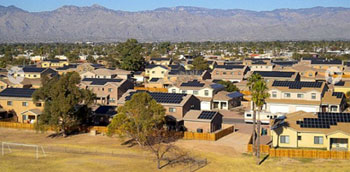When we observe the reactions to Ebola and ISIS, it’s hard not to feel jealous because we believe climate change also deserves to be treated as an emergency.
But there are two key differences. First, for many climate change still seems like a distant threat. That’s largely due to the second difference, which is that no one disputes the existence of Ebola or ISIS, but politicians confuse the public about the threat of climate change every single day.
The Pentagon isn’t confused however. They explicitly say they are integrating climate change threats into all "plans, operations, and training" across the entire agency.
They also say, "While scientists are converging toward consensus on future climate projections, uncertainty remains. But this cannot be an excuse for delaying action. Every day, our military deals with global uncertainty. Our planners know that, as military strategist Carl von Clausewitz wrote, "all action must, to a certain extent, be planned in a mere twilight."
And "Politics or ideology must not get in the way of sound planning."
Solar covers rooftops at the Army’s Fort Bliss base in Texas as part of Project SolarStrong:

The Department of Defense (DoD) 2014 Climate Change Adaptation Roadmap starts this way:
"Climate change will affect the Department of Defense’s ability to defend the Nation and poses immediate risks to U.S. national security."
"Rising global temperatures, changing precipitation patterns, climbing sea levels, and more extreme weather events will intensify the challenges of global instability, hunger, poverty, and conflict. They will likely lead to food and water shortages, pandemic disease, disputes over refugees and resources, and destruction by natural disasters in regions across the globe."
This makes climate change a "threat multiplier" because it can exacerbate challenges from infectious disease to terrorism. And the impacts are already there for those who choose to see them.
Lack of food and water, and now the spread of disease, can "undermine already fragile governments" creating openings for conditions that foster terrorism." Indeed, it never made the headlines, but it was four years of terrible drought that led to the uprising in Syria.
Read our article, As Climate Change Worsens, So Will Human Violence.
"A changing climate will have real impacts on our military and the way it executes its missions. The military could be called upon more often to support civil authorities, and provide humanitarian assistance and disaster relief in the face of more frequent and more intense natural disasters. Our coastal installations are vulnerable to rising sea levels and increased flooding, while droughts, wildfires, and more extreme temperatures could threaten many of our training activities. Our supply chains could be impacted, and we will need to ensure our critical equipment works under more extreme weather conditions. Weather has always affected military operations, and as the climate changes, the way we execute operations may be altered or constrained."
World Bank Group president Jim Yong Kim made similar remarks in a speech last week when he said not acting on climate change could have the same results as inaction on Ebola. "Ebola and climate change have a few things in common. Most importantly, we are running out of time to find solutions to both. Also, until very recently, the plans to fight them were either nonexistent or inadequate. And inaction is literally killing people – one because of the rapid spread of a deadly virus, the other from the poisoning of the atmosphere and the oceans. And finally, perhaps most critically from our point of view, resolving these problems is essential to development, whether from the perspective of human suffering, economic growth or public health."
We’ve written many articles about how DoD is tackling climate change within agency operations from the Navy running on biofuels to solar installations at Air Force and Army bases.
Read our article, Solar’s Growing Role in the US Military.
Read the Department of Defense 2014 Climate Change Adaptation Roadmap:
